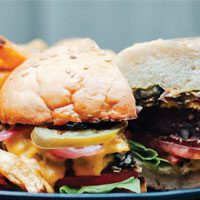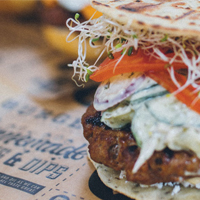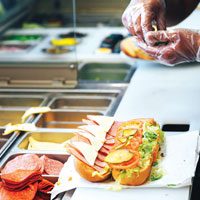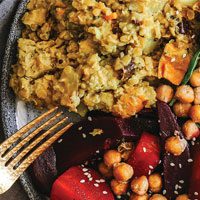
CANNABIS EDIBLES
Although “Cannabis 2.0” regulations came into effect late last year, at this time, cannabis-infused food and beverages cannot be legally offered in restaurants.
However, the realm of cannabis edibles is creating future opportunities for enterprising foodservice operators.
And, while many cannabis-infused food products are set to take on forms such as chocolate and other confectionary products, some foodservice professionals are thinking more outside the box when it comes to their offerings.
While constrained by current regulations, several Canadian chefs are positioning themselves as go-to resources for those seeking to explore infused dining, with some even offering private infused-dining events and cooking classes.
In Toronto, chef Ted Corrado has joined ByMINISTRY to develop programs and menus for the company’s culinary lab, school and lounge, as well as its events and dining club. The company is currently advocating and encouraging governments to legislate cannabis-consumption spaces and, once legalized, Corrado will offer gourmet cannabis-infused menus across byMINISTRY’s spaces.
Danny Raposo — known as The Stoner Chef — became famous following his television debut on Masterchef Canada’s first season in 2014. He credits cannabis edibles for helping him live with chronic pain and is now using his knowledge to help others.
“I help people who have been dealing with pharmaceuticals for years — painkillers, from Tylenol 3’s to Percocet,” he says. “These [people] might be taking up to 14 pills per day. I help people get off those pills by slowly incorporating CBD and THC into their everyday diet.”
From chronic pain to depression and anxiety, he believes nutritionally balanced infused foods are the best way to treat such ailments in a way that won’t result in addiction.
“I’m trying to do regular, healthy food. For lunch, I’ll make a big salad with beautiful ingredients and infuse the salad dressing to ensure my clients are getting their medicine,” he explains. “It’s unfortunate the market looks set to be saturated with candies and sugar-loaded snacks — what’s that going to look like in four years?”
Raposo also has concerns about the conservative limits current regulations enforce on commercial recreational edibles. Infused products are limited to a dosage of 10 mg of THC (tetrahydrocannabinol, the main psychoactive compound in marijuana) per serving.
“Ten mg is not enough THC for a patient,” he explains. “I consume 100 mg just for breakfast. Patients would need to eat 10 cookies in the morning to get the medicine they need with the current legal dosage rate.”

SINGLE-USE PLASTICS
In a country as geographically large as Canada, with many municipalities and rules regarding recycling and composting, single-use plastics have become a much larger problem than for smaller regions with more streamlined recycling programs.
“Part of the issue is people think they can recycle things that they can’t,” says Jo-Ann McArthur of Nourish Marketing. “We need to look at closed-loop systems if we really want to tackle this [single-use plastic] problem.”
Technomic’s Take: 7 hot Trends to Watch for 2020 maintains our formerly linear approach to recycling is turning into a more cyclical (or, as McArthur says, closed-loop) system as foodservice operators attach themselves to more innovative systems for reducing consumption and making use of more compostable or biodegradable types of packaging.
“A lot of this is going to be about trying to change our behaviour as consumers,” McArthur continues. “Do most people really need straws? Do we really need this convenience when it has such a massive [environmental] impact? In terms of takeaway containers, we’re starting to see a move away from black plastic, which is good, but there’s still too much of it out there.”
Foodservice solutions for closed-loop systems of packaging, dining materials and waste management are on the rise. Compostable packaging will be an important solution for operators and U.S.-based eco-brand Loliware is working to bring these items to Canadian foodservice.
Featuring a product line “designed to disappear,” Loliware will be launching its hyper-compostable and marine-degradable straws internationally starting this year. While straws will be its first product launch, it’s likely other products will follow — all made with its intelligent seaweed-based technology.
The straws have a mouthfeel similar to plastic, can withstand up to 18 hours of constant use and are 100-per-cent tree free. According to a Loliware representative, its straws are now available throughout Canada.
“It’s funny, single-use plastic wasn’t even a term a few years ago and now it’s something every consumer asks about,” says McArthur. “A&W was the first in Canada to ban straws; it’s moved to paper straws — they’re okay; they’re not great. There are a lot of permanent-straw options now where you can bring your own, which works if you carry a purse.”
Andrew Lavers, Distribution manager and Environmental Initiatives leader at A&W Canada, says its approach to sustainability works for its business model, which is built around time-honoured tradition.
“It’s our responsibility to make changes that matter. Over the years, we’ve continued to demonstrate our commitment to reducing our environmental impact through industry-leading waste-reduction initiatives,” he says. “In our restaurants, it’s all about what’s reusable. Drinks are served in glass mugs and we have a complete line up of ceramic dishes, plates, metal baskets and real cutlery. Other packaging, such as takeout bags, drink containers and food wrappings, are all 100-per-cent compostable and recyclable where facilities exist and have been since 2013.”

TRANSPARENCY & TRUST
If there’s one foodservice trend operators can be certain of, it’s that Canadian diners will continue to demand information about how their food is sourced. Developing a greater understanding of our food system is now a goal for many Canadians, whether for environmental, ethical or health-and-wellness reasons.
“For Canadian consumers, it’s not about wanting ‘traceability’ — that’s an industry term,” Jo-Ann McArthur, president of Toronto-based Nourish Food Marketing, says. “It’s about transparency and trust. They want to know who’s growing their food. Is it local? Is it a real person? [Currently], only 10 per cent of Canadian consumers have ever visited a farm —there’s a serious disconnect between consumers and producers.”
In Vancouver, Janna Bishop and Shira McDermott of Flourist have made it their mission to bring fully traceable grain products to both operators and consumers who crave a closer connection with their food. Offering premium-quality grains, beans and flours, Flourist stone-mills its products to order and works exclusively with Canadian, family-run farms in Manitoba, Alberta and Saskatchewan.
Bishop says the recent push towards higher levels of traceability in Canadian food products has a lot to do with living in an increasingly globalized world.
“There’s much more awareness now [about the world],” she explains. “Social media has connected us, globally, in ways we’ve never before experienced, which has also shone a light on the injustice of our food systems and the impact these systems have on people and the planet. People are looking for answers in the foods they eat.”
Generational shifts in how we eat contribute to this larger trend of maintaining ethical food systems. Many younger diners are environmentally driven and well-educated on the effects of industrial farming and pesticides on the environment. Bishop believes Flourist’s approach to transparency helps alleviate potential distrust between Canadian consumers and food producers.
“We work with a select group of Prairie-based family farms who grow all the products we sell,” she says. “We ship the grains and legumes to our warehouse in Vancouver to be milled into flour or we repack the whole grains and legumes for our online, retail and restaurant customers. We share the farm of origin and information about the farmer on every item we sell — and we have an illustration of the farmer on each of our retail boxes. Transparency is one of our core values, so it’s a part of everything we do.”
Bishop says, for its wheat products, the main concerns of Flourist’s clients are quality, flavour and nutrition. For products such as quinoa, however, the issues become as much about ethics as quality.
“Most quinoa is grown and harvested in South America, where there are many reports of unsafe and unethical labour practices being used,” she says. “Canadians are making more ethical changes in their retail habits and it’s only a matter of time before they start making similar demands of their favourite restaurants.”

PLANT-BASED ALTERNATIVES
As Canadian diners continue to choose plant-based food options for environmental and personal-health reasons, plant-based meat alternatives are enjoying a renaissance — largely thanks to product lines such as Beyond Meat and Impossible Foods, which regularly make headlines for its apparently perfect meat-like texture and flavour.
Subway Canada now features Beyond Meat products with its Beyond Meatball offerings and senior Marketing director Cristina Wells says the test runs of the product have been overwhelmingly positive.
“We tested the Beyond Meatball last year in select markets and received an outpouring of support and positive feedback,” she says. “Canadians can look forward to even more culinary menu options stemming from the partnership soon.”
In the past, plant-based meat wasn’t an important segment of foodservice, since many vegetarian or vegans weren’t necessarily looking for imitation meat. Now, as more Canadians who identify as flexitarians look for everyday plant-based foods, making satisfying items that imitate the taste and texture of meat has led chefs and operators to think creatively.
Chef David Lee, of Planta and Planta Burger, regularly serves omnivore diners plant-based foods. He credits his own health-and-wellness journey as the driving force behind his shift to plant-based cooking. His Planta Burger is a combination of mushrooms, legumes and beets and captures the look, feel and indulgent taste of a high-end burger.
“The recipe took us a long time to develop and perfect,” Lee says. “Ultimately, we want our guests to feel satiated after eating a Planta burger.”
When it comes to meat alternatives, are all burgers created equal? A&W launched its Beyond Meat burger in 2018 and sold out within the first few weeks of its launch. While many describe these plant-based meat replacements as delicious and a positive way forward, others have started questioning the sourcing of the ingredients and overall healthfulness.
“I don’t think these burgers can be compared to a chef’s version,” Lee remarks. “It’s similar to the way a packaged meal will never compare to one cooked at home.”
Toronto-based food journalist Deborah Reid has been researching plant-based meat alternatives for some time, in partnership with scientific journalist Dr. Cathie Bellingham. Bellingham studies the nutritional content of plant-based meat alternatives, while Reid — a seasoned chef — rates the flavour and textures of the items they sample.
“Cathie comes at this not only from a scientific perspective, but also as a vegan,” Reid explains. “Although I eat meat, my diet leans heavily toward plant-based eating. In general, [I can say that] where so many plant-based products fall down is in the area of nutrition, which is critical.”
Reid feels, overall, we may be congratulating ourselves too soon regarding advancements in plant-based meat alternatives currently on the market.
“It feels like we should be farther along on this front than we are.There’s so much hype in the [current] market, it’s hard to evaluate it rationally,” she says. “In my research on plant-based products, including milks, I’ve found the protein and essential-vitamin content in many of them is horrendous. People who need this nutrition regularly use these products, believing they’re an equivalent and they just aren’t.”

FOOD WASTE
According to THP’s 2020 Flavour & Trend Forecast, more than 570,000 tonnes of fresh, useable meat gets thrown away, globally, every year. In fine-dining operations, whole-animal butchery and a zero-waste approach to cooking is gaining traction, with many chefs developing close working relationships with both farmers and small-scale suppliers.
At Canoe in Toronto, chef de cuisine Ron McKinley practises whole-animal butchery as he has for much of his career.
“I show respect for the animal by ensuring nothing goes to waste,” he says. “Additionally, if you don’t use all the bits and bobs that come along with a whole carcass, you can’t maximize the flavour of your dish.”
By using bones and trim for sauces and the cheaper cuts in addition to choice cuts from the animal, McKinley ensures the plates he delivers Canoe’s clientele are of the calibre they expect and also profitable for the restaurant.
“[It’s about] making the most out of the animal and also teaching younger cooks in the kitchen how to work properly,” he continues. “If they don’t learn these things in a place like Canoe, and now, where and when else are they going to learn?”
Using the whole animal is less costly and gives chefs an advantage — from one lamb, McKinley knows he will get 36 portions, including one primary cut, one secondary cut, a braise, some bacon made from the belly and a piece of shoulder, all per plate. This takes any risk of wastage out of the equation. It also helps that Canoe is a high-volume restaurant with plenty of staff to make this system work.
“We’re lucky,” McKinley admits. “We have plenty of hands to do this work and attract the kind of staff that want to learn.”
For 34 years, Second Harvest has been helping solve Canada’s food-waste problem by relieving operators of edible wastage and redistributing it through social-service programs to provide hunger relief for under-privileged Canadians. More recently, it’s developed a grassroots program to help with smaller amounts of food waste called FoodRescue.
FoodRescue — launched throughout the province of Ontario in fall 2018 — provides operators with a flexible and customizable option to donate surplus food, regardless of amount.
“This is not for the big things,” Jo-Ann McArthur of Nourish Marketing says. “FoodRescue has developed an app where social-service organizations can register. For example, if you’re a registered organization on Toronto’s West End and the local No Frills has several leftover HMR meals, it can input them into the app and social services can collect right away. It’s not just hyper-local; they’re connecting where those five meals can make a significant impact — even though the donation isn’t big enough for the charity.”

STREET FOOD
Technomic’s 2019 Canadian Emerging Channels Consumer Trend Report tells us 52 per cent of Canadian diners surveyed said if their favourite food truck were to open a restaurant, they would likely visit. Over the years, street food has been redefined as a genre — where it once represented hot dogs and French fries, it now covers a range of foods, from wood-fired pizzas to fish tacos.
Matt Basile has long been heralded as one of Toronto’s top minds in relation to the evolution of Canadian street food. His street-food company, Fidel Gastro’s, has been serving the masses his now-famous Pad Thai fries and other comfort-food favourites since 2013.
“We started a food truck more out of necessity than anything, so I guess it was street food by association,” Basile laughs. “We couldn’t afford to open anything larger. [After a while], we saw how our company was evolving and that there was a market for a street-food approach to restaurant food. From there, we launched Lisa Marie.”
Running on the momentum the Fidel Gastro’s food truck created, Basile and his team opened the street-food-centric, stand-alone restaurant Lisa Marie on Toronto’s Queen Street. Now closed, Lisa Marie focused on a community feel, with regular events such as spaghetti-and-meatballs night and Burgers, Beer and Bingo, which took place each Tuesday.
Now, Basile focuses on catered events and the continued success of the Fidel Gastro’s food truck, which is available for private hire as well as its regular haunts throughout Toronto.
“We used to have to explain what a street-food company was. Now, people have an idea of what that is without any explanation,” Basile says. “In my cookbook [Street Food Diaries, 2014], I write about what it means to be a street-food chef — and it doesn’t mean we make hot dogs for a living. Street food is a genre, just like French or Italian [cuisine], but it’s food for the people.”
Canada’s street-food trend isn’t urban-centric. A true food for the people, food trucks and street-food-inspired restaurants have proven to be just as popular in rural regions. In Cape Breton, N.S., the food truck Stand and Stuff Your Face serves locals and tourists within the small, lakeside community of Baddeck, while down the road at Big Spruce Brewery in Nyanza, Cape Breton, you can order a pint of your favourite craft brew to have alongside fresh haddock tacos at its Farm to Fork Food Truck.
“As an industry, I’m seeing more operations embrace the term ‘street food’ — it’s becoming more commonplace,” Basile says. “I’m noticing quite a few newer spots [in Toronto] where I see ‘street food’ in the actual name of the restaurant, which is interesting. Now, you don’t have to get it from a stall, anymore.”

LAB-GROWN PROTEINS
It may sound frightening and futuristic to some, but lab-grown meat and dairy (also known as cultured protein) could have a bright future in Canadian foodservice. Alberta-based Future Fields is an organization dedicated to the development of lab-cultured proteins without the use of expensive “serum” — which is what many other cellular agricultural groups use to grow meat cells and what currently makes lab-grown meat so expensive.
The first lab-grown burger, produced in 2013, cost US$325,000. Prices are now significantly lower, but still nowhere near affordable to the average consumer.
According to the Good Food Institute in the U.S. (which helps provide funding to many cellular-agriculture start-ups within North America), food technology and cellular agriculture will “save the world,” which is set to grow to nearly 10-billion people by 2050.
Other Canada-based cellular-agriculture groups include Appleton Meats in Vancouver and a University of Toronto-based team led by Dr. Peter Stogios. Lab-grown meats and dairy products are made using stem cells from animals, but do not require large amounts of land and are made with cruelty-free methods.
While product development is well-underway and prices are set to eventually become more affordable, it will be some time before we see lab-grown meat on our shelves and menus. Future Field’s website says wide-scale acceptance of this technology, along with complementary research in the areas of distribution and manufacturing, is integral to its overall success.
According to the most recent research from Technomic, however, it may take time for consumers to see the potential of cellular agriculture, with 59 per cent of consumers strongly agreeing they would be hesitant to eat beef grown in a lab. The research shows 59 per cent say the same for pork. Provided by Technomic’s senior manager of Consumer Insights, Anne Mills, this data is from consumers who eat beef or pork at least once every two to three weeks.
For now, environmentally conscious Canadian diners support operators who are committed to sustainable farming practises and source their proteins ethically. Nuburger, in Winnipeg, features an extensive burger menu with ingredients sourced within Manitoba, from farms who raise their animals on grass and home-grown grain.
Co- founders Kyle Matheson and Marc Priestley, along with chef Osten Rice, developed their menu to combat what they call “the burger hangover.”
“We love burgers, but we don’t love how horrible we felt after eating them,” Priestley says. “We wanted to make burgers delicious, but better for you. All our protein is grilled and our plant-based options are made from scratch with wholesome ingredients.”
In addition to offering a healthier burger experience, Nuburger has taken a zero-waste approach to its restaurants since it opened.
“It’s all about supporting local farms and trying to reduce our carbon footprint,” Priestley continues. “We compost and recycle as much as humanly possible — all our takeaway products are compostable. In our restaurants, nothing is single use. We’ve always wanted to do what we thought all restaurants should be doing.”

FOOD HALLS
Food halls, indoor marketplaces and unique concept shop-and-dine experiences are officially replacing the shopping-mall food courts of yesteryear. These unique spaces are popping up all over the country and offer diverse food options alongside unique or high-end retail.
Technomic’s 2019 Canadian Emerging Channels Consumer Trend Report shows 37 per cent of consumers say these types of dining experiences often introduce them to dishes they’ve never tried before and 45 per cent say they prefer to eat globally inspired
cuisines, such as Thai or Ethiopian.
Canada’s socially vibrant cities bring a world of opportunity to enterprising food-hall vendors and operators. Richmond Public Market is a popular food hall in the B.C. city, which offers a wide range of globally inspired dishes, such as Cantonese barbecue and hand-pulled noodles, while Montreal’s Marché Artisans food hall features everything from sushi to charcuterie, with online ordering and catering services.
Toronto’s newest food marketplace is already a global household name. Eataly has taken up residence at the Manulife Centre in Yorkville and officially opened its doors this past November. Dino Borri, Eataly’s vice-president of Global Partnerships, says Eataly’s approach to dining and retail is steeped in authenticity and providing a rich guest experience.
“Eataly is an experience that encourages guests to eat, shop and learn about authentic Italian food,” he says. “We’re excited for Canadians to taste our delicious dishes in our rest- aurants, learn about Italian cuisine and shop local Canadian and Italian products — at the best value and highest quality — and to recreate the authentic Italian recipes at home.”
Canadian diners understand and enjoy global flavours now more than ever before, making Eataly a much-anticipated addition to Toronto’s dining and retail scene.
“Canadians are increasingly interested in learning about the food they’re eating and buying, which is why our approach is resonating with them,” Borri explains. “If you eat better, you live better.”
Following the hyper-local route to globally inspired eating, Eataly features representation from each Italian region and features takeaway counters, cafés and sit-down restaurants with a variety of Italian foods, from high-end, chef-driven dishes to Neapolitan-style pizzas.
Dana McCauley of Ontario-based food-marketing brand Blue Unicorn Innovation says the current food-hall trend is, at its core, consumer driven.
“Food halls are spot on aligned with current demand. Millennials — as well as other generational cohorts — are interested in a food experience versus a fine-dining experience,” she explains. “These spaces offer lots of variety, visual and auditory stimuli and allow groups with different tastes and needs to have a meal together, stock up on specialty items and learn about food.”

CUSTOMIZATION
When it comes to customization in foodservice, Canadians know what they want. According to Technomic, custom- ization continues to be an important factor in the decision-making process for Canadian diners — especially within fast-casual or QSR operations.
Technomic’s Canadian Pizza Consumer Trend Report shows 48 per cent of consumers would order a build-your-own pizza from food-service, which is higher than for specific pizza builds such as Hawaiian or barbecue chicken. The 2019 Canadian Burger Consumer Trend Report reports 47 per cent of consumers consider customization important when deciding where to order a burger from, while 54 per cent of consumers strongly agree they’re willing to wait up to two minutes longer for a custom build-your-own burger.
Dana McCauley, director of Blue Unicorn Innovation, says diners, as paying customers, have the right to customize their meals.
“I’m a marketer. In my opinion, the customer is always right,” she says. “I have no patience for restaurants that say you can’t have cheese on your seafood linguine.”
For Subway Canada, customization is a deeply rooted feature of its business model. Offering its iconic submarine sandwiches and salads since 1965, Subway was among the first QSR chains to offer complete customization of its menu. This currently includes a choice of sauces, toppings, proteins and an array of breads and wraps.
Cristina Wells, Subway Canada’s senior Marketing director, believes today’s larger trend pertaining to customization is a combination of generational consumer demand and the average Canadian having a busier lifestyle.
“We now live in an age of customization and individual experience that goes beyond the restaurant world,” she says. “Emerging and improved technology has changed how we buy clothing, consume media and entertainment and, of course, how we eat and our relationship with food. In recent years, we’ve seen rapid growth with customization technologies in the QSR space. With this new technology, including remote ordering and mobile rewards apps, consumers can get an individualized ordering experience with fully customizable meal options at the touch of a button.”
Making use of the technologies available, the Subway app allows diners to build their meal on the screen and then add the order to favourites, which enables a faster experience. Wells says Subway Canada is expanding on its customization offerings in other ways, as well.
“Our Signature Flavour Stations began entering into select restaurants last year,” she says. “Guests can create a new flavour experience every time they walk into one of our restaurants.”

PLANT-FORWARD MENUS
As plant-forward menu items grow in popularity among Canadian diners, operators across all segments will look to innovate in this area. No longer considered an afterthought, plant-based foods are becoming more deeply intertwined with regular menu items to meet consumer demand. Many Canadians — even those who identify as meat-eaters — are choosing more plant-based options, believing they’re healthier and more environmentally sustainable.
Creating appealing plant-based menu items can be daunting, even for seasoned chefs, because they often require technique and skills that, until recently, weren’t taught in traditional culinary schools.
The Rouxbe Online Culinary School offers training solutions to all types of foodservice operations with its new plant-based curriculum. Working with well-known hospitality brands, as well as institutional operators (among other industry partners), Rouxbe offers flexible on-the-job training focused on making the most of a plant-based menu item.
“In 2014, Rouxbe launched the first online, professional plant-based certification program for chefs,” says Ken Rubin, Rouxbe’s Chief Culinary Officer. “Now, what our [industry] partners need is a way to deploy our professional chef-certification program into the industry, but with included plant-based instruction. As a result, we developed a 30-hour plant-based foundation course, which has some assumptions built in — it’s geared toward a working cook who needs specific training.”
Incorporating plant-based dairy alternatives, starches, legumes and skills — such as making seitan (a meat alternative) from scratch — Rouxbe’s plant-based foundation course is a firm introduction to plant-based cooking for seasoned chefs. Since it’s online, chefs can learn in their own time or, if part of a larger operation, during regular group training sessions.
“We’re creating online tools that don’t interfere with a brand’s own training programs,” Rubin says. “We plug in to help magnify structural context and it’s up to the operator as to how they want to deploy our programs. There are many good reasons to create more plant-based menu items — it’s a way to be responsive and do the right thing while helping your bottom line.”
Xica Jicama is creating a plant-based product line using jicama (a Central-American tuberous vegetable). It’s ideal for diabetics, promotes bone health, is naturally low in calories, is rich in fibre and vitamin C and well-suited to a variety of culinary techniques. Available Xica products include jicama spears, tortillas and tacos.
“Jicama is naturally grain-free and carbohydrate rich,” says Enrique Mateos, founder of Xica Jicama. “It’s high inulin (a starchy substance found in a wide variety of fruits, vegetables and herbs) content promotes bone health and protects against osteoporosis, with plenty of vitamins to boost immunity while improving overall digestion.”
Written by Janine Kennedy

















